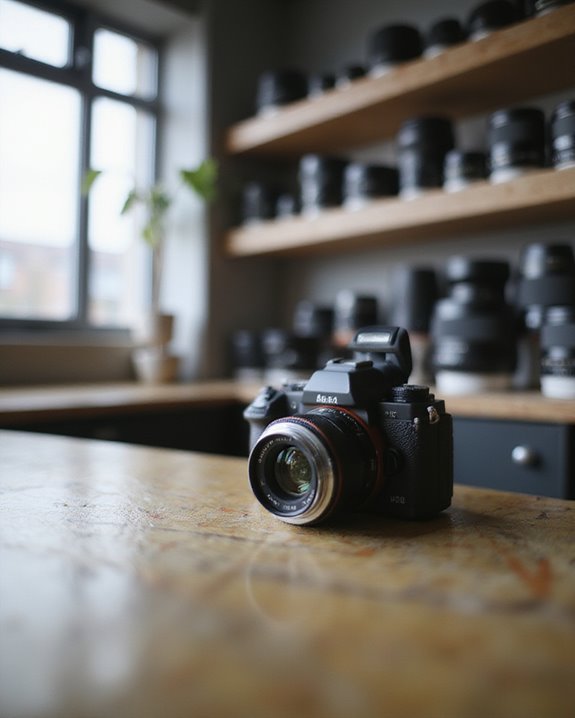A versatile lens collection typically starts with a standard zoom (35-85mm) for everyday shots, complemented by a prime lens (f/1.8 or wider) for superior low-light performance and portrait work. Add a wide-angle lens (24mm or shorter) for landscapes and architecture, and consider a telephoto zoom (70-200mm) for distant subjects. Specialty lenses like macro or tilt-shift address specific needs as your photography skills develop. The right selection depends on your primary subjects and shooting style.
Key Takeaways
- Start with a standard zoom lens (35-85mm) as a versatile option for everyday photography situations.
- Consider a prime lens with wide aperture (f/1.2-f/1.8) for superior low-light performance and beautiful background blur.
- Add a wide-angle lens (35mm or shorter) for landscapes, architecture, and environmental portraits.
- Invest in a telephoto lens (80mm+) for wildlife, sports, and portrait photography with subject isolation.
- Choose lenses based on your specific photography needs rather than collecting gear for every possible situation.
Understanding Camera Lens Basics
The intricate world of camera lenses extends far beyond simple glass elements, serving as the critical interface between photographer and subject. Camera lenses comprise several components, including the filter thread, front element, lens hood thread, zoom ring, and focus ring—each serving distinct functions in image creation. Aperture and light sensitivity significantly influence the exposure and overall quality of images, especially in low-light conditions. Photographers must grasp fundamental characteristics such as focal length, which determines angle of view, and aperture size, which controls light entry and depth of field. Aperture effects greatly impact image aesthetics, with wider apertures (lower f-numbers) creating shallow depth of field ideal for portraits, while smaller apertures maximize sharpness across the frame. Proper lens maintenance guarantees ideal performance, preventing dust accumulation on the front element that could degrade image quality. Understanding lens terminology and specifications printed on the barrel helps photographers make informed decisions when selecting equipment for specific photographic applications.
The Essential Standard Zoom Lens
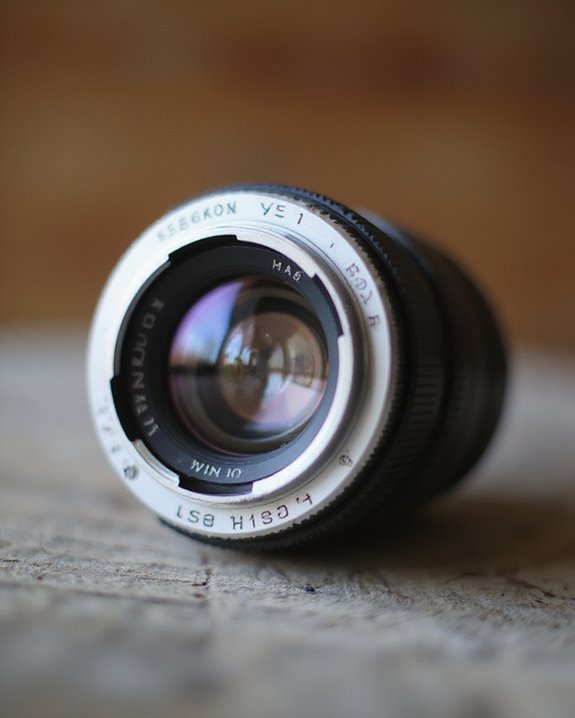
Among professional photographers and enthusiasts alike, the standard zoom lens represents the cornerstone of most camera systems, providing unmatched versatility across a range of shooting situations. Covering approximately 35-85mm focal lengths, these lenses bridge the gap between wide-angle and telephoto perspectives, with the 50mm range closely matching natural human vision.
Modern standard zooms feature impressive specifications, including constant apertures of f/2.8-4, effective optical stabilization systems providing 3-5 stops of shake compensation, and close-focus capabilities of 0.3-0.5m. Regular zoom maintenance guarantees ideal performance, while proper stabilization techniques maximize sharpness in challenging conditions. Despite common misconceptions, today’s standard zooms rival prime lenses in optical quality, making them suitable for everything from street photography to environmental portraits, all while maintaining professional-grade weather resistance in premium models. Additionally, high-quality 24-105mm lenses often incorporate advanced optical coatings and stabilization systems, ensuring clarity and sharpness across the zoom range.
Prime Lenses: When Fixed Focal Length Matters
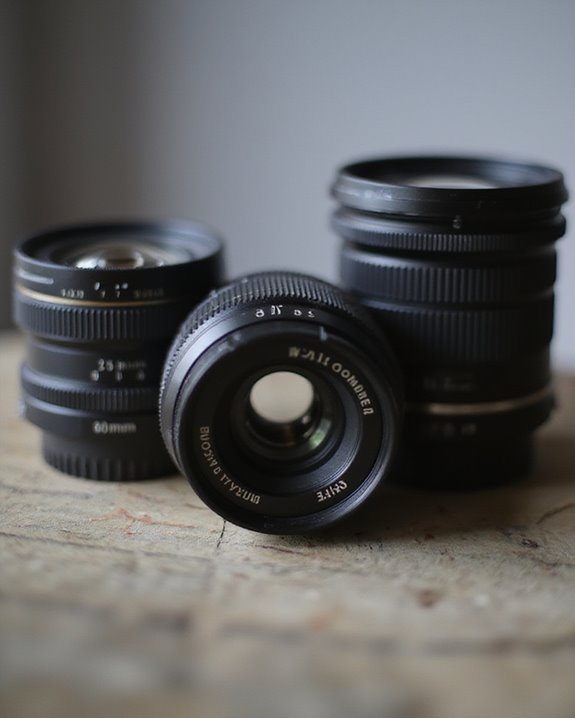
While standard zoom lenses offer tremendous versatility, prime lenses represent a distinctly different approach to photography that many professionals consider indispensable in their creative arsenal. These fixed focal length optics deliver exceptionally sharp images with minimal distortion due to their simpler optical design and fewer glass elements.
The aperture benefits of prime lenses cannot be overstated, as their typical maximum apertures of f/1.2 to f/1.8 provide superior low-light performance and create beautifully blurred backgrounds that isolate subjects effectively. This characteristic makes them particularly valuable for portrait, street, and low-light photography situations. Though they require photographers to physically move to compose shots rather than zooming, this limitation often results in more thoughtful composition and creative framing. Their generally compact size and lighter weight also make prime lenses excellent companions for photographers who prioritize portability.
Expanding Your Range With Wide-Angle Lenses
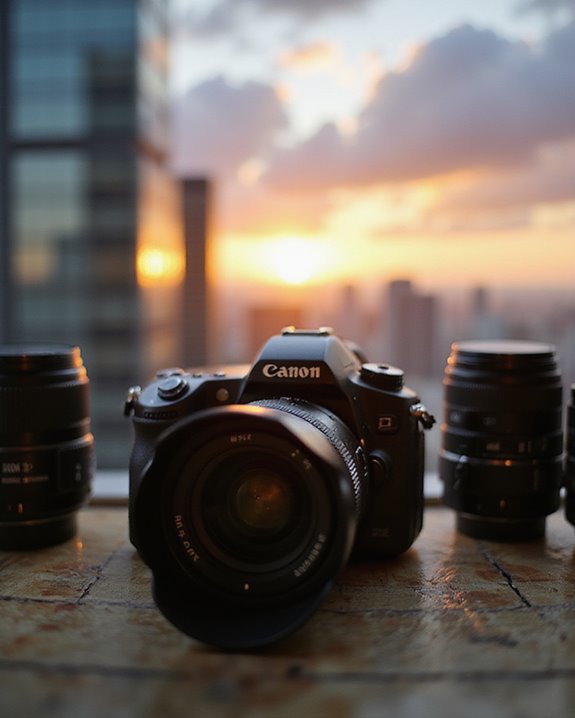
Venturing beyond standard focal lengths, wide-angle lenses fundamentally transform a photographer’s creative possibilities, offering dramatically expanded fields of view at focal lengths of 35mm or shorter. These versatile tools excel in landscape photography, architectural documentation, and capturing dynamic street scenes with immersive perspectives.
Wide-angle lenses come in various forms: standard wide (24-35mm), ultra-wide (under 24mm), and fisheye variants, each serving distinct creative purposes. When photographing interiors, these lenses reveal interior angles impossible to capture with standard lenses, providing complete spatial context. Their inherent characteristics enhance depth perception by exaggerating distances, making foreground objects appear larger while pushing backgrounds further away.
Photographers seeking to tell more complete visual stories benefit from wide-angle lenses’ ability to maintain sharp focus throughout the scene, effectively framing subjects within their environmental context.
Telephoto Options for Distant Subjects
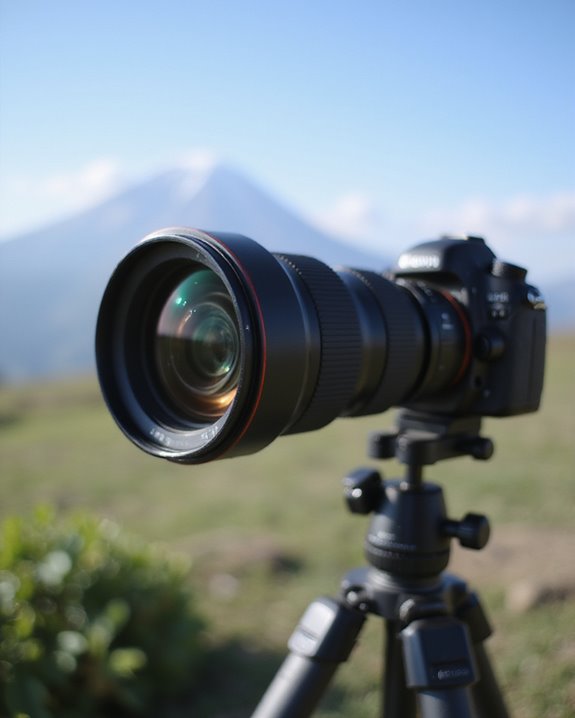
Telephoto lenses represent an essential category for photographers seeking to capture distant subjects with remarkable clarity and detail, offering focal lengths typically starting at 80mm and extending well beyond 300mm for specialized applications. These lenses compress perspective while providing substantial magnification, making them indispensable for Distant Wildlife photography where approaching subjects might be impractical or dangerous. The shallow depth of field characteristic of telephoto optics creates dramatic Action Isolation, effectively separating subjects from potentially distracting backgrounds. Available in both prime and zoom configurations, telephoto lenses vary greatly in weight, aperture capabilities, and price points. While prime telephotos typically deliver superior optical quality and wider maximum apertures, zoom variants offer greater flexibility for dynamic shooting scenarios. Photographers must consider the trade-offs between focal length, aperture, portability, and budget when selecting the appropriate telephoto lens for their specific needs, especially given the advancements in image stabilization technology that help achieve sharper handheld shots.
Specialty Lenses for Unique Photography Needs
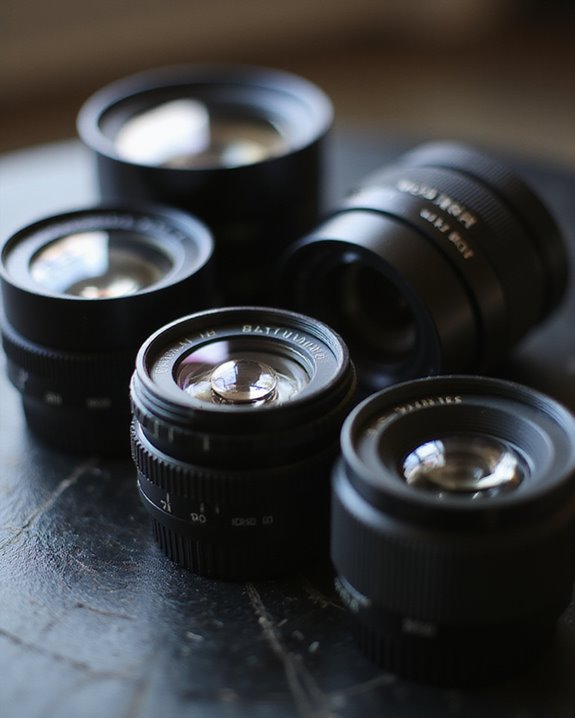
Beyond standard options in a photographer’s kit, specialty lenses open doors to photographic possibilities that standard glass simply cannot achieve, enabling artists to capture unique perspectives and visual effects without digital manipulation. Macro lenses reveal intricate details of insects and products with 1:1 magnification ratios and close focusing distances under 12 inches. Tilt-shift lenses offer versatile applications, creating both perspective control for architecture and the popular “miniature” Tilt Effects through selective focus manipulation. Fisheye options deliver dramatic 180°+ views with characteristic curved horizons, while creative effect lenses produce distinctive Anamorphic Bokeh patterns and selective focus swirls. For cinematographers, specialty cinema lenses include anamorphic options that create oval bokeh and distinctive flares, plus probe lenses that enable macro cinematography in confined spaces.
Frequently Asked Questions
Can I Use Vintage Lenses on My Modern Digital Camera?
Like ghosts from photography’s past, vintage lenses can indeed mount on modern digital cameras through specialized adapters. However, they typically require manual focusing and may lose electronic communication with the camera body.
How Often Should Camera Lenses Be Professionally Serviced?
Professional camera lenses typically require service every 1-3 years depending on usage. Service frequency varies with professional equipment needing annual maintenance intervals, while consumer-grade lenses can go 2-3 years between professional servicing.
Do Weather-Sealed Lenses Eliminate the Need for Rain Covers?
Weather-sealed lenses offer improved protection through Sealing Benefits, but do not eliminate the need for rain covers during heavy or prolonged precipitation. Proper Weather Maintenance still requires additional protection for maximum equipment longevity.
How Do Third-Party Lenses Compare to Manufacturer-Branded Options?
Like gems of varying karats, third-party lenses offer significant cost savings (30-50% less) while many match manufacturer performance metrics. Modern options deliver comparable sharpness and autofocus reliability, though quality varies across manufacturers and price points.
Can Lens Filters Degrade Image Quality or Affect Autofocus?
High-quality, well-maintained filters minimally impact image quality, while cheaper ones can reduce sharpness by 10%. Proper filter maintenance prevents degradation. Autofocus tips: remove filters in challenging light conditions to avoid ghosting that may confuse focus sensors.


